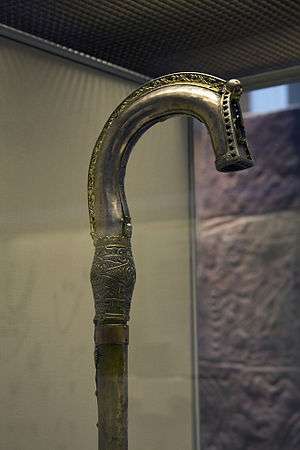Kells Crozier
The Kells Crozier or British Museum Crozier is a mediaeval Irish bishop's staff that has been part of the British Museum's collection since 1859.[1] This rare object, one of only four extant complete examples known from Ireland, mysteriously appeared in London in 1850, before being acquired by the museum.
| Kells Crozier | |
|---|---|
 Kells Crozier | |
| Material | Silver and copper |
| Size | 133 cm long |
| Created | 9th-11th Centuries AD |
| Present location | British Museum, London |
| Registration | 1859.2-21.1 |
Description
The Kells Crozier was made by various craftsmen over at least two different periods between the late 9th and 11th century AD. While the core of the crozier is wooden, the crook is made of silver and the staff is covered in a copper alloy sheet which was later covered with silver mounts or knobs filled with animal interlace typical of the period. The curved crest of the crook is elaborately decorated with interlinking birds; where this meets the straight end of the crook a human head appears. This is where the crozier would have once held some holy relics. Its total length measures about 133 cm.
History of the Crozier
Underneath the crest of the crook is engraved an inscription in mixed Latin and the old Irish language: "ordo conduilis ocius do mel finnen", which, roughly translated, asks supplicants to pray for Cúduilig and Maelfinnén who were involved in its refurbishment. Scholars have identified these names with individuals who were connected with the important Irish monastic settlement at Kells, County Meath. However, recent research has cast doubts about this connection. The crozier was found without explanation in the cupboard of a London solicitor's office in the middle of the nineteenth century. It subsequently belonged to several owners (including Cardinal Wiseman) before being purchased by the British Museum.
A copy of the Kells Crozier can be viewed in the Tourist Office in the Courthouse, Kells, Co. Meath.
Reliquary Deposit
A key role of the Kells Crozier was to act as a repository for holy relics for the pious faithful. Enshrining items which had once belonged to saints or church leaders, such as their bones or parts of their clothing, was an important feature of religious life in early medieval Ireland. Other reliquaries common to Ireland in this period were the bell shrines, such as St Patrick's Bell in the National Museum of Ireland [2] and St Conall Cael's Bell in the British Museum.[3]
Gallery
 The crest of the crook
The crest of the crook Full length of the crozier
Full length of the crozier One of the mounts or knobs
One of the mounts or knobs
Further reading
- M. MacDermott, 'The Kells Crozier', Archaeologia-12, 96 (1955), pp. 59–113
- F. Henry, Irish art during the Viking Invasions (London, Methuen, 1967)
- R. Ó Floinn, Irish shrines and reliquaries (National Museum of Ireland, Dublin, 1994)
- P. Harbison, The golden age of Irish art (London, Thames and Hudson, 1999)